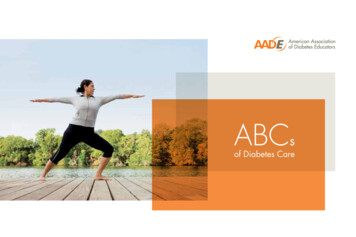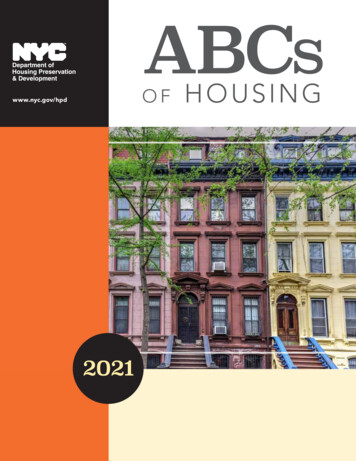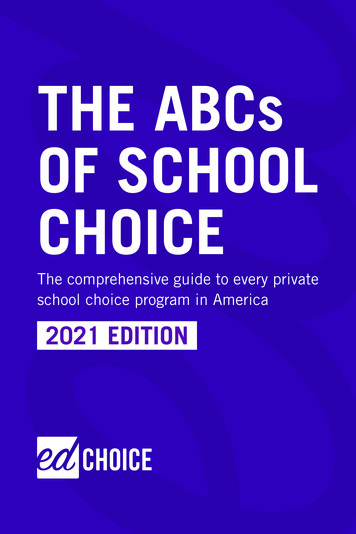
Transcription
THE ABCsOF SCHOOLCHOICEThe comprehensive guide to every privateschool choice program in America2021 EDITION
ABOUT EDCHOICEEdChoice is a nonprofit, nonpartisan organization dedicatedto advancing full and unencumbered educational choice asthe best pathway to successful lives and a stronger society.EdChoice believes that families, not bureaucrats, are bestequipped to make K–12 schooling decisions for their children.The organization works at the state level to educate diverseaudiences, train advocates and engage policymakers on thebenefits of high-quality school choice programs. EdChoice isthe intellectual legacy of Milton and Rose D. Friedman, whofounded the organization in 1996.
THE ABCsOF SCHOOLCHOICEThe comprehensive guide to every privateschool choice program in America2021 EDITION
Table of ContentsPreface. 2Types of Private School Choice.3 4Other Types of School Choice. 5 6School Choice Illustrated. 7–8State Index. 9 12Education Savings Account Programs. 13–24School Voucher Programs. 25–84Tax-Credit Scholarship Programs.85–134Individual Tax Credit and Deduction Programs. 135–136529 Savings Accounts. 137–138Rules and Regulations. 139–154Legal History. 155–166Data Sources for Program Profiles. 167Methodology and Data Sources for Eligibility. 168
Happy 25th anniversary to EdChoice—formerly the Friedman Foundation forEducational Choice!We’ve spent the past quarter-century fighting to expand educational opportunities for allstudents regardless of their income level or ZIP Code, and we’ll keep pursuing that fight foras long as it takes to level the playing field for all children. I hope you’ll join us throughoutthe year as we remember our past—and our founders—and look toward the future.Each year, we issue this publication to provide detailed information about private schoolchoice programs across the country. Some are brand new; others are decades old. Theyare a reflection of the hard work that parents, educators, policymakers and advocates haveundertaken to improve our K–12 landscape.Along with the ABCs, we also publish companion pieces—EdChoice 101 and The EdChoiceStudy Guide—in Spanish and English to help break down the basics for those who are new tothe issue of school choice. We’ll also be introducing EdChoice Legal 101 to make it clear whyschool choice is constitutional and explain the legal history that’s evolved over the decades.As we have in past editions of the ABCs, this year we break down private school choiceprograms into four categories, but we place more emphasis on education savings accounts(ESAs), vouchers and tax-credit scholarships because they provide the most direct supportto those who utilize them.We also want to highlight other mechanisms available for families to choose schools,including charter and magnet schools, inter- and intra-district transfer programs,homeschooling and microschooling—the reimagining of the one-room schoolhouse,where class sizes are usually fewer than 15 students of varying ages, and the schedule andcurriculum is tailored to fit the needs of each class.As always, you can find more information about schooling types and school choice programson our website, which is updated with new data throughout the year. You also can orderadditional free copies of the ABCs as well as our companion publications.The past year presented new challenges for families as they navigated the economics andacademics of a global pandemic, with many parents bringing classrooms into their livingrooms or scrambling to find new schooling types. Some who didn’t previously have a choicewere empowered to try new options. Others realized the system wasn’t working for them—and wanted to find a way out.We will work in the coming years to make sure that all families can access what theyneed to educate their kids because, quite honestly, it’s just that simple. We appreciate yoursupport for educational choice and your commitment to our work and our future.Yours sincerely,Robert C. EnlowPresident and CEO2
Types of PrivateSchool ChoiceEDUCATION SAVINGS ACCOUNTSESAs allow parents to withdraw their children from publicdistrict or charter schools and receive a deposit of public fundsinto government-authorized savings accounts with restricted,but multiple, uses. Those funds—often distributed to familiesvia debit card—can cover private school tuition and fees, onlinelearning programs, private tutoring, community college costs,higher education expenses and other approved customizedlearning services and materials. Some ESAs, but not all, evenallow students to use their funds to pay for a combination ofpublic school courses and private services.SCHOOL VOUCHERSVouchers give parents the freedom to choose a private schoolfor their children, using all or part of the public funding set asidefor their children’s education. Under such a program, fundstypically expended by a school district would be allocated to aparticipating family in the form of a voucher to pay partial or fulltuition for their child’s private school, including both religiousand non-religious options.3
TAX-CREDIT SCHOLARSHIPSTax-credit scholarships allow taxpayers to receive full orpartial tax credits when they donate to nonprofits that provideprivate school scholarships. Eligible taxpayers can include bothindividuals and businesses. In some states, scholarship-givingnonprofits also provide innovation grants to public schools and/or transportation assistance to students who choose alternativepublic schools.INDIVIDUAL TAX CREDITS & DEDUCTIONSIndividual tax credits and deductions allow parents to receivestate income tax relief for approved educational expenses, whichcan include private school tuition, books, supplies, computers,tutors and transportation.4
Other Types ofSchool ChoiceCHARTER SCHOOLSCharter schools are independently run public schools exempt from many rules andregulations in exchange for increased accountability. Typically, if charters receivemore applications than they have open seats, they must accept students based ona lottery. Families do not need to use ESAs, vouchers or tax-credit scholarships topay to enroll their children in charter schools as these schools are already publiclyfunded.MAGNET SCHOOLSA magnet school is a public school that offers specialized curricula and programsnot available in traditional neighborhood public schools. Magnets are designed toattract students with a common interest or skillset, and students must apply andbe accepted to enroll. Families do not need to use ESAs, vouchers or tax-creditscholarships to pay to enroll their children in magnet schools as these schools arealready publicly funded.INTER/INTRA-DISTRICT PUBLIC SCHOOL CHOICESometimes referred to as open enrollment, inter- and intra-district choicelaws allow families to choose traditional public schools other than the ones thegovernment assigned based on their ZIP Codes. Intra-district choice allows familiesto choose from among more than one public school within their assigned district.Inter-district choice allows families to send their children to any traditional publicschool in their resident state or a defined region. Typically, these open enrollmentoptions still allow public schools to give enrollment preference to students withintheir assigned district lines.HOMESCHOOLINGHomeschooling is an alternative form of education for children outside of publicor private schools, typically within their own homes. Homeschooling is regulateddifferently from state to state.5
ONLINE LEARNINGOnline learning allows students to work with their curriculum and teachers overthe internet—in combination with, or in place of, traditional classroom learning.Online schools can be public or private. Families may also use some educationalchoice options, such as ESAs and vouchers, to pay for online and virtual schooling.CUSTOMIZED LEARNINGCustomized learning is unique to every child. As an example, some studentsmight use ESA or course choice programs to mix courses from public schools withprivately tutored classes at home, online courses, special education therapies and awork-study internship. The possibilities are endless, especially as new innovationsin learning continue to emerge.TOWN TUITIONINGGenerally speaking, town tuitioning allows students who live in towns that don’thave district public schools to receive their per-pupil education tax dollars to paytuition at a neighboring town’s public school or a private school of their choice—sometimes even across state lines for families who live close to state borders. Thistype of school choice functions much like a school voucher, and only a handful ofrural states in the northeast use it.MICRO-SCHOOLINGMicro-schooling is the reimagining of the one-room schoolhouse, where class sizesare usually fewer than 15 students of varying ages, and the schedule and curriculumis tailored to fit the needs of each class. This model of schooling can operate ineither public, private or charter schools or separately on its own.HYBRID HOMESCHOOLINGHybrid homeschooling is an educational model where students split their timebetween homeschooling and a traditional classroom setting.6
Number of Currently Enacted PrivateSchool Choice Programs by Year Launched7059 606065 20142011201226201020071823 242008200514 1991199219901955198718691873108 96 75555553 41 21012 12 1220042020200930063Number of ESAs, Vouchers andTax-Credit ,000100,00001991 199219931994 19951996 19971998 1999 2000 2001 2002 2003 2004 2005 2006EDUCATION SAVINGS ACCOUNT7VOUCHER
Spending on ESAs, Vouchers and Tax-CreditScholarships as a percent of combined programand public K–12 current and total expendituresCurrent expenditures include instruction, support services, food services and enterprise operations. Totalexpenditures include those categories and also capital outlay, interest payments on debts and programs outside ofpublic elementary/secondary education, such as adult education and community services.0.442%0.45% 3.1 Billion of a projected combined 705.2 Billion0.410%(2020–21) CURRENT EXPENDITURES0.435%0.347% 2.5 Billion of a combined 737.3 Billion0.334%(2017–18) TOTAL 19961993199419910.00%19920.004%ProjectedNote: Only includes expenditures in states and Washington, D.C.Sources: EdChoice (2021), The ABCs of School Choice: The Comprehensive Guide to Every Private School Choice Program in America, 2021 Edition; NationalCenter for Education Statistics, Table 163. Total expenditures for public elementary and secondary education, by function and subfunction: 1989-90 to 1994-95,retrieved from nces.ed.gov/programs/digest/d97/d97t163.asp; National Center for Education Statistics, Table 165. Summary of expenditures for publicelementary and secondary education, by purpose: Selected years, 1919-20 through 2004-05, retrieved from nces.ed.gov/programs/digest/d07/tables/dt07 165.asp; National Center for Education Statistics, Table 236.10. Summary of expenditures for public elementary and secondary education and other relatedprograms, by purpose: Selected years, 1919-20 through 2013-14, retrieved from nces.ed.gov/programs/digest/d16/tables/dt16 236.10.asp; 7 236.10.asp; National Center for Education Statistics, Table 236.10. Summary of expenditures for public elementary andsecondary education and other related programs, by purpose: Selected years, 1919-20 through 2015-16, retrieved from 8 236.10.asp; National Center for Education Statistics, Table 236.10. Summary of expenditures for public elementary and secondaryeducation and other related programs, by purpose: Selected years, 1919-20 through 2016-17, retrieved from 9 236.10.asp; Stephen Q. Cornman, Lei Zhou, Malia Howell, Jeremy Phillips, and Jumaane Young (2020), Revenues and Expenditures for Public Elementaryand Secondary Education: FY 18 (NCES 2020-306), retrieved from https://nces.ed.gov/pubs2020/2020306.pdf; William J. Hussar and Tabitha M. Bailey (2020),Projections of Education Statistics to 2028 (NCES 2020-024), retrieved from https://nces.ed.gov/pubs2020/2020024.pdf#page 61Approximately 608,000 in 2020–21329,393248,82529,4752007 2008 2009 2010 2011 2012 2013 2014 2015 2016 2017 2018 2019 2020 2021TAX-CREDIT SCHOLARSHIPTAX CREDIT AND DEDUCTION8
State IndexALABAMAAlabama Accountability Act of 2013 Parent-Taxpayer Refundable Tax Credits. 135Education Scholarship Program.87ARIZONAOriginal Individual Income Tax Credit Scholarship Program.89Low-Income Corporate Income Tax Credit Scholarship Program. 91Lexie’s Law for Disabled and Displaced Students Tax Credit Scholarship Program. 93Empowerment Scholarship Accounts. 15“Switcher” Individual Income Tax Credit Scholarship Program.95ARKANSASSucceed Scholarship Program. 27DISTRICT OF COLUMBIAOpportunity Scholarship Program.29FLORIDAJohn M. McKay Scholarships for Students with Disabilities Program. 31Florida Tax Credit Scholarship Program. 97Gardiner Scholarship Program. 17Hope Scholarship Program.99Family Empowerment Scholarship Program. 33GEORGIAGeorgia Special Needs Scholarship Program. 35Qualified Education Expense Tax Credit.101ILLINOISTax Credits for Educational Expenses. 135Invest in Kids Program. 103EDUCATION SAVINGS ACCOUNT9VOUCHER
Each state’s programs are listed inorder by date enacted.INDIANASchool Scholarship Tax Credit. 105Choice Scholarship Program. 37Private School/Homeschool Deduction. 135IOWATuition and Textbook Tax Credit. 135School Tuition Organization Tax Credit. 107KANSASTax Credit for Low Income Students Scholarship Program. 109LOUISIANALouisiana Scholarship Program.39Elementary and Secondary School Tuition Deduction. 135School Choice Program for Certain Students with Exceptionalities. 41Tuition Donation Credit Program. 111MAINETown Tuitioning Program.43MARYLANDBroadening Options and Opportunities for Students Today (BOOST) Program.45MINNESOTAEducation Deduction. 135K–12 Education Credit. 135MISSISSIPPIMississippi Dyslexia Therapy Scholarship for Students with Dyslexia Program.47Nate Rogers Scholarship for Students with Disabilities Program.49Equal Opportunity for Students with Special Needs Program. 19TAX-CREDIT SCHOLARSHIPTAX CREDIT AND DEDUCTION10
State Index (continued)MONTANATax Credits for Contributions to Student Scholarship Organizations.113NEVADAEducational Choice Scholarship Program.115NEW HAMPSHIRETown Tuitioning Program. 51Education Tax Credit Program.117NORTH CAROLINASpecial Education Scholarship Grants for Children with Disabilities. 53Opportunity Scholarships. 55Personal Education Savings Accounts. 21OHIOCleveland Scholarship Program. 57Autism Scholarship Program.59Educational Choice Scholarship Program. 61Jon Peterson Special Needs Scholarship Program. 63Income-Based Scholarship Program.65OKLAHOMALindsey Nicole Henry Scholarships for Students with Disabilities. 67Oklahoma Equal Opportunity Education Scholarships.119PENNSYLVANIAEducational Improvement Tax Credit Program.121Opportunity Scholarship Tax Credit Program. 123EDUCATION SAVINGS ACCOUNT11VOUCHER
Each state’s programs are listed inorder by date enacted.PUERTO RICOFree School Selection Program.69RHODE ISLANDTax Credits for Contributions to Scholarship Organizations. 125SOUTH CAROLINAEducational Credit for Exceptional Needs Children. 127Refundable Educational Credit for Exceptional Needs Children. 135SOUTH DAKOTAPartners in Education Tax Credit Program. 129TENNESSEEIndividualized Education Account Program.23Education Savings Account Program. 71UTAHCarson Smith Special Needs Scholarship Program. 73Special Needs Opportunity Scholarship Program.131VERMONTTown Tuitioning Program. 75VIRGINIAEducation Improvement Scholarships Tax Credits Program. 133WISCONSINMilwaukee Parental Choice Program. 77Parental Private School Choice Program (Racine). 79Parental Choice Program (Statewide). 81K–12 Private School Tuition Deduction. 135Special Needs Scholarship Program.83TAX-CREDIT SCHOLARSHIPTAX CREDIT AND DEDUCTION12
EducationSavingsAccounts(ESAs)ESAs allow parents to withdraw their children from public districtor charter schools and receive a deposit of public funds intogovernment-authorized savings accounts with restricted, butmultiple, uses. Those funds—often distributed to families via debitcard—can cover private school tuition and fees, online learningprograms, private tutoring, community college costs, higher educationexpenses and other approved customized learning services and materials.Some ESAs, but not all, even allow students to use their funds to payfor a combination of public school courses and private services.529,475 10,349 71%ProgramsTotal StudentsAverage Amountof PublicSpending(National)Number of Students Using 14201520162017School Year Ending132018201920202021
NCESATNAZMSFLProgram IndexAZFLMSNCTNEmpowerment Scholarship Accounts.15Gardiner Scholarship Program.17Equal Opportunity for Students with Special Needs Program.19Personal Education Savings Accounts.21Individualized Education Account Program.23Watch How ESAs WorkHold your device's camera over this QR code and click the link that pops up to watcha short video about how this type of program works for state budgets and for families.14
ArizonaEmpowerment ScholarshipAccountsEducation Savings Account Enacted 2011 Launched 2011Arizona’s Empowerment Scholarship Accounts (ESA) program allows parents to withdraw theirchildren from public, district or charter schools and receive a portion of their public funding depositedinto an account with defined, but multiple, uses, including private school tuition, online education,private tutoring or future educational expenses.INCOME LIMITNoneGEOGRAPHIC LIMITTESTING MANDATEPRIOR YEAR PUBLIC SCHOOL REQUIREMENTStatewideNoneENROLLMENT CAPACCOUNT CAPPARENT REQUIREMENTS pg. 145YesNone100/90% Charter/District FundingGOVERNING STATUTES Ariz. Rev. Stat. §§ 15-2401 through 2404Student FundingStudents in households that earn up to 250 percent of poverty ( 65,500 for a family of four in 2020–21)will receive ESAs funded at 100 percent of the base for whichever school type the student previouslyattended (charter or district). For all other students, ESAs are funded at 90 percent of the same perstudent base funding ( 5,394 for students in K–8 and 5,669 for high school students in 2020–21).ESAs were worth about 6,148 for students in grades 1–12 who do not have special needs in 2018–19.Students with special needs receive additional funding, and those amounts vary depending on theservices the student’s disability requires. Because a majority of ESA students have special needs, theaverage ESA in 2020–21 is projected to be more than 14,000.Student EligibilityStudents must have previously attended public school for at least 100 days of the prior fiscal year andmet one of the following characteristics: (1) received a scholarship from a school tuition organization(STO) under Lexie’s Law, (2) attended a “D” or “F” letter-grade school or school district, (3) beenadopted from the state’s foster care system, (4) is already an ESA recipient or (5) live on a NativeAmerican reservation. Students eligible to attend kindergarten are also eligible provided they meetone of the above criteria. Additionally, children of active-duty military members stationed in Arizona,children whose parents were killed in the line of duty, children of parents who are legally blind, deaf orhard of hearing, and siblings of current or previous ESA recipients are also eligible. Children of activeduty military members or whose parents were killed in the line of duty are not required to attenda public school prior to applying for an ESA. Finally, preschool children with special needs are alsoeligible and are not required to have attended a public preschool program prior to applying.EdChoice Expert FeedbackArizona’s ESA program helps thousands of students access schools that are the right fit for them, butpolicymakers could do more to expand educational opportunity.Several categories of students are eligible to receive an ESA, including students with special needs,foster kids, students assigned to low-performing district schools, Native Americans on reservations,the children of active-duty military personnel, and more. About 22 percent of Arizona studentsare eligible to receive an ESA, and all Arizona students are eligible to receive a scholarship via the15
Program ParticipationEnrollment in Arizona's education savings accounts program eclipsed 10,000 students for the firsttime in 2019–20.10,865 33027612012201320143,5471,3342015ESAStudents Participating12,000201620172018201920202021School Year Ending10,850 23% 134ParticipatingStudents(Fall 2020)of 14–15) 6,599Median ESA Award(2018–19) 13,118Average AccountValue(2020–21 Projected)EdChoice Expert Feedback (continued)90%Maximum Account Valueas a Percentage of PublicSchool Per-Student Spending(For Non-Low-Income Students)144%Value as a Percentageof Public School PerStudent Spending (AverageIncluding Students withSpecial Needs)(Maximum)individual-donor scholarship program. Statewide, recipients participating in one of Arizona’s privateeducational choice options (including the universal-eligibility Original Individual-Donor TaxCredit Scholarship Program, the Low-Income Corporate-Donor Tax-Credit Scholarship Program,“Switcher” Tax-Credit Scholarship Program and Lexie’s Law for Disabled and Displaced Students TaxCredit Scholarship Program) represent about 7 percent of the state’s enrollment. This is the highestEdChoice share in the nation.ESAs are funded at 90 percent of the state’s per-pupil funding (or 100% for low-income students).Many ESA students receives about 6,150 annually, but students with special needs get significantlymore. Funding amounts vary based on the types of special needs.In order to expand access to educational choice, Arizona policymakers should expand eligibility forthe ESA program to all students and eliminate the “100-day prior public” requirement that arbitrarilyinhibits families’ access to educational choice.Arizona’s ESA program generally avoids unnecessary and counterproductive regulations.Additional Arizona programs on pages 89, 91, 93, 95For the latest program information and data updated in real time, visit edchoice.org/AZ ESA16
FloridaGardiner Scholarship ProgramEducation Savings Account Enacted 2014 Launched 2014Florida’s Gardiner Scholarship Program allows students with special needs an opportunity to receivean education savings account (ESA) funded by the state and administered by an approved scholarshipfunding organization. Parents can use the funds to pay for a variety of educational services, includingprivate school tuition, tutoring, online education, home education, curriculum, therapy, postsecondaryeducational institutions in Florida and other defined educational services.INCOME LIMITNonePRIOR YEAR PUBLIC SCHOOL REQUIREMENTGEOGRAPHIC LIMITStatewideTESTING MANDATEState or NationalPARENT REQUIREMENTS pg. 145ENROLLMENT CAPACCOUNT CAPGOVERNING STATUTESYesYes100/90% Charter/District FundingFla. Stat. §1002.385Student FundingThe General Appropriations Act (state budget) provides funding for Florida’s Gardiner ScholarshipProgram and specifies the annual amount. The per-pupil amount varies according to grade, county ofresidence and public school spending for students with disabilities, with the maximum equating to 90percent of the cost of the matrix of services a student would receive from a school district. The Floridalegislature appropriated 189.9 million to the ESA program for 2020–21. ESAs are prorated based onthe academic quarter in which the student is deemed eligible for the ESA by a scholarship-fundingorganization.Student EligibilityTo be awarded an ESA, students must be between the ages of 3 and 22 or be in 12th grade, whichevercomes first. Students must have an Individualized Education Plan or have been diagnosed by aphysician or psychologist with one of the following: autism spectrum disorder, cerebral palsy, Downsyndrome, an intellectual disability, muscular dystrophy, Phelan-McDermid syndrome, Prader-Willisyndrome, spina bifida, Williams syndrome, anaphylaxis, dual sensory impairment or rare diseaseswhich affect patient populations of fewer than 200,000 Americans. Students are also eligib
laws allow families to choose traditional public schools other than the ones the government assigned based on their ZIP Codes. Intra-district choice allows families to choose from among more than one public school within their assigned district. Inter-district choice allows families to send their children to any traditional public



